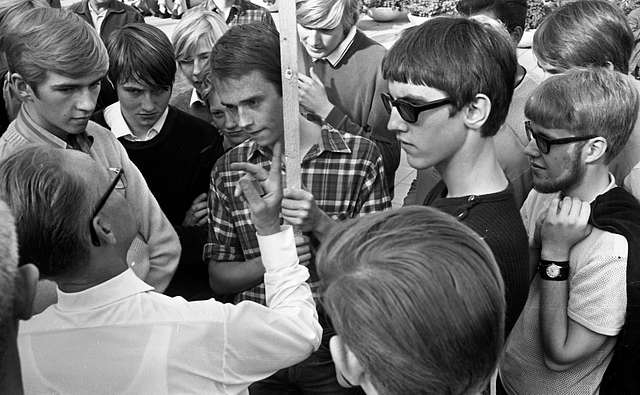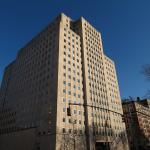In yesterday’s post, we discussed mainline liberal Protestantism, which once served as the “conscience of the nation,” and how after its collapse, neither Evangelicals nor Catholics have been able to fill that void. I mentioned that I grew up in mainline Protestantism and experienced it from the inside. I witnessed its influence and I was there when its influence started to disintegrate.
As I said in yesterday’s post (which you might want to read if you haven’t already), when I was 17, I was selected in a process I don’t remember to be part of a program that would send a delegation of youth from the Disciples of Christ to the halls of power in New York City and Washington, D.C.
At this time, The Secular City by Harvey Cox was all the vogue, which maintained that today the Holy Spirit is working outside the church, in the dynamic energy of the big cities. Our denomination wanted us young people to experience that, and so did I!
The flight to New York was my first trip on an airplane! Instead of hitting the usual tourist spots, we went to Greenwich Village where the folk scene was blossoming. We went to an off-Broadway play by Ionesco. We went to a church held in a theatre-in-the-round space, which followed the Scripture reading with an “epistle from the world,” drawn straight from the New York Times. We went to the United Nations, learned its inner workings and were taught the virtues of global government. We did a simulated role playing gamesin which we represented different countries and were given a crisis, which we had to handle without causing World War III.
In Washington, we continued to stroll through the halls of power as if we owned the place. We visited the Embassy of Mexico where the Ambassador talked to us about the problems of third world nations, as his servants poured coffee into our delicate china cups (the first time I tasted coffee–didn’t like it much). A group of us with a young pastor were walking through the tunnel connecting the Senate Office Building to the Capitol when we saw a sort-of familiar face. “Isn’t that Gene McCarthy?” We went up to him and all shook his hand. He had a distracted look on his face. That was because this was the day after his big showing in the New Hampshire primary that caused President Lyndon Johnson to drop out of the race.
Which brings up the turning point in mainline Protestant influence: the Vietnam War. This replaced the Civil Rights Movement as the cause for the “moral conscience of the American social order.” At church camp, sometime later (my parents made me go to everything church-related), our resource person was a Lutheran pastor–probably the first Lutheran I had ever knowingly met–from a denomination called the Lutheran Church Missouri Synod. He had a beard, a cynical wit, and struck us young Oklahomans as quite cool. He used the Bible much more than we were used to. His presentations were all about getting us to oppose the Viet Nam War.
This was in the late Sixties, before the SEMINEX walkout in 1974. A significant portion of the LCMS wanted to join the Protestant Mainline. Some of our theologians and pastors were swept up into the ideals, the energy, and the apparent success of the new Christianity, with its ecumenism and social justice crusading.
Opposing the war, though, was a harder sell to ordinary Americans than the Civil Rights movement. Though in retrospect there is broad agreement across the political spectrum today hat the war was not a good idea, at the time, when many church members had sons fighting and dying in Vietnam, the anti-war rhetoric struck them as insulting and unpatriotic. The nation’s polarization then was far worse than what we complain about today. And it was the Democrats that had been primarily waging the war, so the anti-war movement set liberals against liberals. All of this was in the context of the youth counter-culture, which split families. The Democratic Convention of 1968–the year of my trip–was accompanied by the Chicago anti-war riots. The Republican nominee Richard Nixon was elected by calling on the “silent majority,” which would morph in the 1970s to the Moral Majority.
In terms of Jake Meadow’s and Joseph Bottum’s “three-legged stool” of government, business, and the mainline church, the church began opposing the government. (Recall that President Eisenhower and Secretary of State John Foster Dulles presided over the groundbreaking of the headquarters of the National Council of Churches. But then Eisenhower’s vice president was anathema, as was Dulles’ Cold War anti-communism.) As mainline Protestantism moved more and more to the left, it began opposing business, demonizing “the big corporations” and American capitalism. (Recall that John D. Rockefeller put up the money to build that headquarters.)
These emphases alienated the people in the pews, who had to admit their pastors were right when they taught that mistreating people because of the color of their skin was both un-Christian and un-American, but they did not like it when the Cold War was raging and their pastors sounded like Communists.
But worst of all, this new version of Christianity, with its leftist social gospel and its downplaying of the supernatural, was ignoring the genuine spiritual needs of the people in the pews. As the Mainline collapsed, evangelicalism went through a resurgence, with disaffected and spiritually unfed Mainliners flocking to evangelical churches.
One more story from my big trip: I had been reading C. S. Lewis and was learning about “mere Christianity”–what Christians of all stripes have historically believed–for the first time ever, despite all my church-and-youth group attending. I was captivated by what I was learning in Lewis’s books, especially when I read about the doctrine of the Incarnation. We were waiting for a subway in New York City when I brought this up with one of the youth pastors on the trip. “So Jesus is God,” I said excitedly. “God actually became a flesh and blood human being like the rest of us! That’s amazing!” I wanted to talk about this, with someone trained in theology who would understand and appreciate this wonder. “Well,” said the young Mainline Protestant pastor. “We really don’t emphasize that anymore.”
I was deflated. Why would a church not emphasize that most wonderful and mind-blowing teaching of Christianity? And what was this “anymore”? It emphasized it at one time, but then stopped doing so? Why? I realized in a flash the inadequacy of the modernist theology I was being fed with. I resolved then and there to look for a church that taught something more. For one reason or another, it took me quite a while to find that, as I have told about elsewhere, but eventually I did.
Photo: VPK- Möte Södertorget 9 september 1968 via Picryl, Public Domain. [No one in this photograph is me. Rather, it is a photo of Swedish young people in 1968 listening to a politician from the Swedish Communist Party. It captures something of what we were then. At least we were intensely interested in things. I did take lots of pictures from my trip, but they were slides–remember those?–and I have no idea where they are.]













